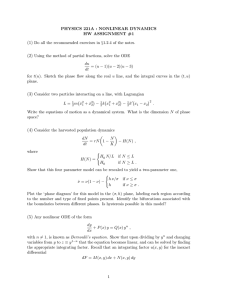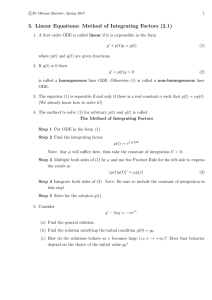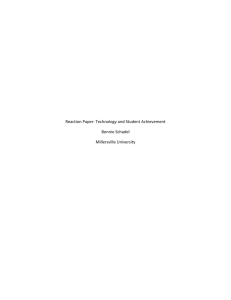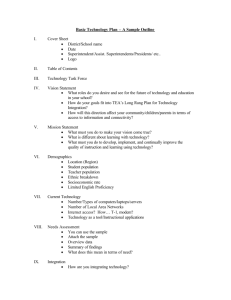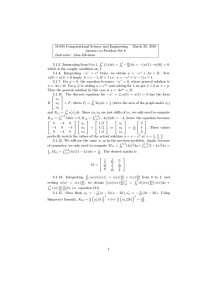, Feb 10, 2010 18.03 Class 4
advertisement
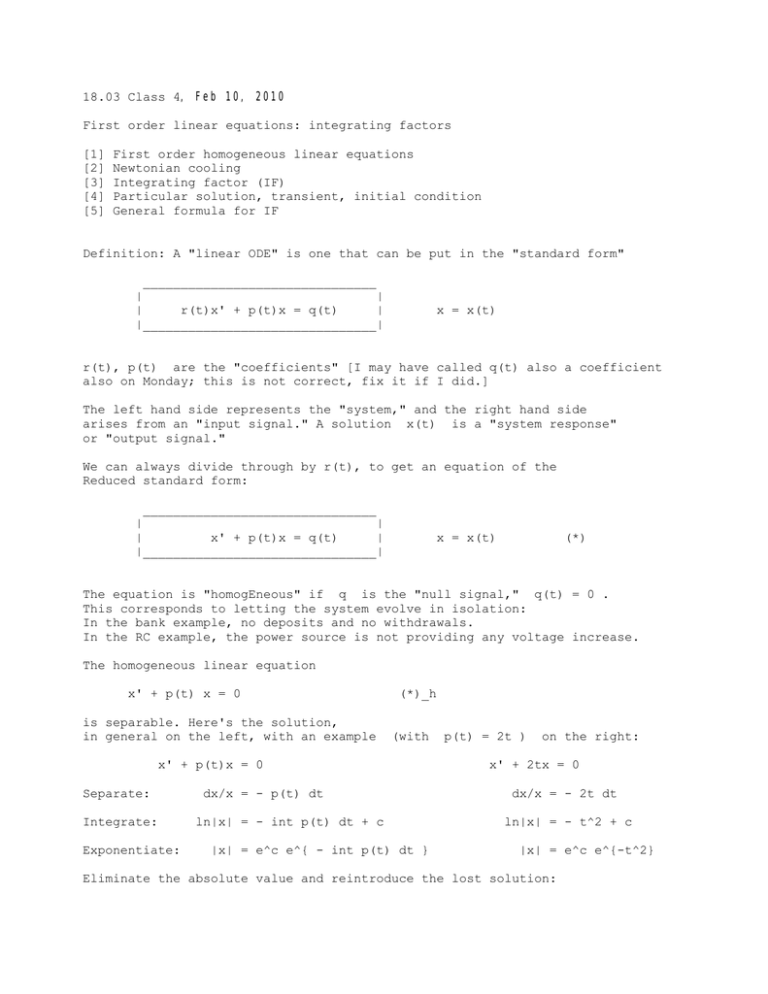
18.03 Class 4, Feb 10, 2010
First order linear equations: integrating factors
[1]
[2]
[3]
[4]
[5]
First order homogeneous linear equations
Newtonian cooling
Integrating factor (IF)
Particular solution, transient, initial condition
General formula for IF
Definition: A "linear ODE" is one that can be put in the "standard form"
_______________________________
|
|
|
r(t)x' + p(t)x = q(t)
|
|_______________________________|
x = x(t)
r(t), p(t) are the "coefficients" [I may have called q(t) also a coefficient
also on Monday; this is not correct, fix it if I did.]
The left hand side represents the "system," and the right hand side
arises from an "input signal." A solution x(t) is a "system response"
or "output signal."
We can always divide through by r(t), to get an equation of the
Reduced standard form:
_______________________________
|
|
|
x' + p(t)x = q(t)
|
|_______________________________|
x = x(t)
(*)
The equation is "homogEneous" if q is the "null signal," q(t) = 0 .
This corresponds to letting the system evolve in isolation:
In the bank example, no deposits and no withdrawals.
In the RC example, the power source is not providing any voltage increase.
The homogeneous linear equation
x' + p(t) x = 0
is separable. Here's the solution,
in general on the left, with an example
(*)_h
(with
x' + p(t)x = 0
Separate:
Integrate:
Exponentiate:
dx/x = - p(t) dt
ln|x| = - int p(t) dt + c
|x| = e^c e^{ - int p(t) dt }
p(t) = 2t )
on the right:
x' + 2tx = 0
dx/x = - 2t dt
ln|x| = - t^2 + c
|x| = e^c e^{-t^2}
Eliminate the absolute value and reintroduce the lost solution:
x = C e^{- int p(t) dt}
x = C e^{-t^2}
In the example, we chose a particular anti-derivative of k , namely
That is what I really have in mind to do in general. The constant of
integration is taken care of by the constant C .
So the general solution to
*any* nonzero solution:
(*)_h
has the form
x_h = e^{- int p(t) dt}
,
C x_h , where
x_h
kt.
is
x = C x_h
We will see that the general case can be solved by an algebraic
trick that produces a sequence of two integrations.
[2] Example: Diffusion, e.g. of heat.
About this time of year I start to think about summer. I put my rootbeer
in a cooler but it still gets warm. Let's model its temperature by an ODE.
x(t) = root beer temperature at time
t .
The greater the temperature difference between inside and outside, the
faster x(t) changes.
Simplest ("linear") model of this:
x'(t) = k ( T_ext(t) - x(t) )
where T_ext(t) is the "external" temperature. Sanity check: When
T_ext(t) > T(t), x'(t) > 0 (assuming k > 0 ). We get a linear equation:
x' - k x
=
k T_ext
This is "Newton's law of cooling." k could depend upon t and we would
still have a linear equation, but let's suppose that we are not watching
the process for so long that the insulation of the cooler starts to break
down!
Systems and signals analysis:
The system is the cooler.
The output signal = system response is x(t) , the temperature in the cooler.
The input signal is the external temperature T_ext(t) .
Note that the right-hand side is k
signal itself.
times the input signal, not the input
What constitutes the input and output signals is a matter of the
interpretation of the equation, not of the equation itself.
Question 4.1: k large means
1. good insulation
2. bad insulation
Blank. don't know.
k is small when the insulation is good, large when it is bad.
It's zero when the insulation is perfect. k is a COUPLING CONSTANT
When it is zero, the temperature inside the cooler is decoupled from
the temperature outside. In the construction industry, a number like
k is pasted on windows; it's called the U-value of the window.
Let's take
k = 1/3 , for example.
Suppose the temperature outside is rising at a constant rate:
T_ext = 60 + 6t
(in hours after 10:00)
and we need an initial condition: let's say
So the IVP is
say
x' + (1/3) x = 20 + 2t ,
x(0) = 32 .
x(0) = 32 .
(cooler)
This isn't separable: it's something new. We'll describe a method which
works for ANY first order linear ODE.
[3] Method: Integrating factors (Euler)
This method is based on the product rule for differentiation:
(d/dt) ( u x )
=
ux' + u'x
For example, suppose we have the equation
t x' + 2 x = t
(This is not separable; it is linear and in standard form, but not reduced
standard form.) Here's a *trick*. Multiply both sides by t :
t^2 x' + 2t x = t^2
The left hand side is now the derivative of a product:
(d/dt) (t^2 x) = t^2
We can solve this by integrating:
t^2 x = t^3/3 + c
so
x = t/3 + c t^{-2}
[In the first lecture, I posed this (with a different righthand side)
as a flashcard problem, but I did it just after describing the calculation
of an integrating factor for a *reduced* equation. The reduced equation is
x' + 2x/t = 1 , and this has integrating factor t^2 . So it was a poorly
placed question.]
That was great! The factor t we multiplied by is an "integrating factor."
I guessed it here. Often you can. The factor to use in the cooler equation
and other equations may not be so obvious. Here's a calculation, for a linear
equation in reduced form,
x' + p(t)x = q(t)
Multiply both sides by
u
u x' + p u x = u q
In order for the right hand side to be
(d/dt)(ux) = ux' + u'x,
the function u must satisfy the differential equation
u' = p u
This is separable, and we'll carry out the separation in general in a minute.
In the cooler equation, the coefficient p(t) is constant.
In that case we have the natural growth equation!
u = e^{pt}
(I am choosing a value for the constant of integration, because I need just
one integrating factor, any one.)
In the case of the cooler problem,
p = 1/3 , so we have:
(d/dt) (e^{t/3} x) = (20 + 2t) e^{t/3}
Integrate:
e^{t/3} x = 60 e^{t/3} + \int 2t e^{t/3} dt
Um. Parts:
\int u dv = uv - \int v du
u = 2t ,
du = 2dt ,
dv = e^{t/3} dt
v = 3 e^{t/3}
e^{t/3} x = 60 e^{t/3} + 6 t e^{t/3} - 18 e^{t/3} + c
= ( 42 + 6 t ) e^{t/3} + c
Solve for
x:
x = ( 42 + 6t ) + c e^{-t/3}
That's the general solution. Remember, you can check it easily.
u is an "integrating factor."
[4] We still should finish the IVP process:
32 = x(0) = 42 + c
so
c = -10 :
x = 42 + 6t - 10 e^{-t/3}
We just want one u , not the general u : so the exponent could be any
antiderivative of p . In the example, p = 1/3 was constant and we took
u = e^{t/3} .
Note the structure of the genearal solution:
x = x_p + c u^{-1}
where
. x_p is a solution, *any solution*. It's called a PARTICULAR SOLUTION
but this is a very poor name, because there is nothing particular about it.
I this case we chose one with a pretty simple formula -- x_p = 42 + 6t .)
.
u
is an integrating factor.
Very often x_h approaches zero with time, as this one does. It is then
called a TRANSIENT. All solutions come to look more and more alike as
time goes on. This is a funnel!
I graphed the solutions 42 + 6t and x , and some others along with T_ext .
If the temperature in the cooler is more than 60 degrees at the start,
then it declines at first, crosses the nullcline x = 60 + 6t where it
is momentarily in equilibrium with the outside, and then rises to become
asymptotic to 42 + 6t like every other solution.
[5] Let's compute an integrating factor for the general first order linear
equation (*) : we are to solve u' = up .
This is a separable equation:
du/u = p dt
ln|u| = int p dt
The constant of integration is in the indefinite integral.
|u| = e^{int p dt}
Now there is a choice of sign. Pick one and go with it; say
u = e^{int p dt}
That gives you an integrating factor. Any nonzero multiple serves as well.
Note that this is the reciprocal of a solution to the homogeneous equation:
u = xh^{-1}
This gets fed into the solution for
x :
x = u^{-1} int u q dt
and the constant of integration in the integral lets us write
x = x_p + c x_h
MIT OpenCourseWare
http://ocw.mit.edu
18.03 Differential Equations
��
Spring 2010
For information about citing these materials or our Terms of Use, visit: http://ocw.mit.edu/terms.

